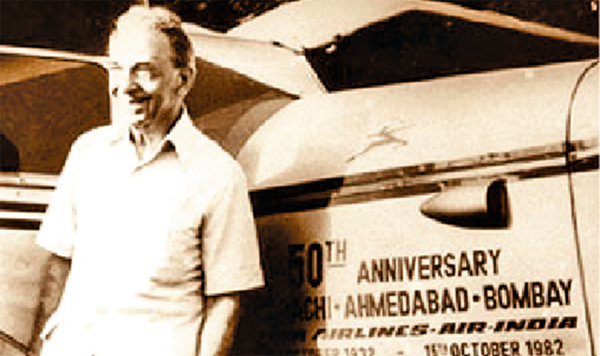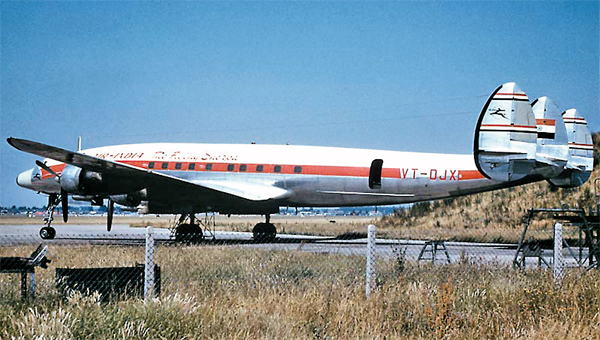|
Karachi was the natural starting point of India’s
first airmail run because the Imperial Airways
flight carrying mail from England landed there.
Tata Aviation Service began with just one DH.80A
Puss Moth and one DH.85 Leopard Moth. The airline’s
staff comprised a whole-time pilot assisted by
Tata and Vintcent, an engineer and two mechanics.
Renamed Tata Air Lines in 1938, it was heavily
dependent on its government contract for carriage
of surcharged mail. Passenger planes were introduced
only after revenues from travellers overtook those
from mail. A few other private airlines like Deccan
Airways, Indian Transcontinental Airlines and
Indian National Airways also commenced operations
within the country.
INDEPENDENT BUT NATIONALISED
JRD Tata became the fourth chairman of the entire
Tata Group in 1939. But aviation remained his
dream and the airline he started his obsession.
He gradually transformed it into one of the world’s
most respected carriers. In July 1946, it was
renamed Air-India and became a public limited
company. The airline operated its first flight
to London on June 8, 1948, and became the national
flag carrier, Air-India International.
In the heady days following Independence, the
domestic market was crowded with no less than
eight carriers of varying size. Under the Air
Corporations Act, 1953, Deccan Airways, Airways
India, Bharat Airways, Himalayan Aviation, Kalinga
Air Lines, Indian National Airways, Air-India
and Air Services of India were merged to form
a single domestic carrier called Indian Airlines
Corporation (IAC). IAC inherited a fleet of 99
aircraft including 74 Douglas DC-3 Dakotas, 12
Vickers VC.1 Vikings, three Douglas DC-4 Skymasters
and sundry smaller aircraft. It started operations
on August 1, 1953, focusing primarily on domestic
routes and international services to neighbouring
countries. The jet age dawned for IAC with the
introduction of the Sud Aviation SE-210 Caravelle
in 1964.

Air-India International was also nationalised
and concentrated on international routes. JRD
Tata was reappointed its chairman and he remained
in the post till February 1978. The carrier entered
the jet age in 1960 with the Boeing 707-420. In
June 1962, its name reverted to Air-India and
it became the world’s first all-jet airline.
In January 1981, a regional airline, Vayudoot,
was established as a joint-venture between Indian
Airlines and Air India in order to serve remote
airports especially in the North East. However,
it never attained financial viability. It became
a wholly-owned subsidiary of Indian Airlines in
1993 and merged with it in 1997.
WAVES OF PRIVATISATION
The three state-owned airlines monopolised Indian
commercial aviation between 1953 and 1993. But
consequent to India’s 1991 economic crisis,
privatisation received fresh impetus through an
‘open skies’ policy. Within a couple
of years, Continental Aviation, East-West Airlines,
Damania Airways, Jagson Airlines, ModiLuft, Jet
Airways and Sahara Airlines began as ‘air
taxis’ before launching scheduled services.
By 1995, private airlines accounted for around
10 per cent of domestic traffic and Indian Airlines
began to face tough competition. However, with
the government determined to protect the interests
of the state-owned carriers, most of the newcomers
began to buckle under fiscal and other restrictions.
By 1997, only Jet Airways and Sahara Airlines
were still functional.
The current wave of private airlines commenced
in 2003 when Air Deccan pioneered the Low-Cost
Carrier (LCC) concept in India. LCC GoAir commenced
operations in 2004. ModiLuft which had ceased
operations in 1996 remerged under new management
as LCC SpiceJet in 2004. While Full-Service Carriers
(FSC) Kingfisher Airlines and Paramount Airways
were launched in 2005, LCC IndiGo took off in
2006.
Then three major mergers happened: Jet Airways
with Sahara (JetLite), Kingfisher with Air Deccan
(Kingfisher Red), and Air India with Indian Airlines.
Subsequently, Paramount, Kingfisher and Kingfisher
Red suspended operations due to heavy losses.
JetLite was merged with Jet Airways’ in-house
LCC JetKonnect in March 2012, allowing JetKonnect
to become a separate airline.
According to the Centre for Asia Pacific Aviation
(CAPA), “In the five years to FY2008 annual
traffic tripled, surging by an incremental 29.1
million, eight times greater than in any equivalent
period before.” India’s third wave of
private airlines finally clicked. Private carriers
now rule the roost having cornered about 80 per
cent of domestic air traffic. However, neither
infrastructure nor policy has kept pace with this
rapid expansion.

THE RUIN OF AIR INDIA
In 2004, Air India still enjoyed over 40 per
cent market share. Then the Ministry of Civil
Aviation (MoCA) decided to augment the carrier’s
fleet by 68, at a crippling cost of over Rs 50,000
crore. It also elected to merge Air India and
Indian Airlines, in the hope that this large carrier
would compete better and also utilise the new
aircraft. As part of the merger, a company called
National Aviation Company of India Limited (NACIL)
was established in 2007. NACIL again became Air
India in October 2010. But Air India rapidly went
downhill. Today, it is a pale shadow of its former
self, racked by massive debts, huge losses and
severe HR problems, from which there’s still
no sign of recovery. It remains afloat only with
massive equity infusion by the government.
RAMPING UP REGIONAL CONNECTIVITY
According to the Route Dispersal Guidelines
formulated in 1994 scheduled airlines were obliged
to deploy a specified percentage of their capacity
on the lucrative mainline routes to connect more
remote and unattractive destinations. However,
while the policy forced the carriers to sustain
heavy losses on unviable routes, regional connectivity
did not greatly improve.
In August 2007, the MoCA introduced a comprehensive
policy to promote regional airlines under which
licences were given for operation of airlines
within a particular region.
Only MDLR Airlines, Air Mantra and Air Costa
actually got off the ground. While the first two
collapsed in quick time, Air Costa seems stable
enough, although it has only been in operation
for a few months and it’s too early to say
if it will succeed or not.
A TIME OF RECKONING
India currently has seven scheduled airlines
and they carried 61.42 million domestic passengers
last year. IndiGo led the pack with the highest
market share, followed by Air India, SpiceJet,
Jet Airways, GoAir, JetKonnect and Air Costa,
in that order. IndiGo is the only convincingly
profitable airline, while GoAir makes money in
some quarters. Plagued by huge debts, overcapacity
and mindless competition, the airline industry’s
health is uncertain. According to CAPA, the industry
posted a combined loss of $1.65 billion in 2012-13
and its performance in 2013-14 may not be much
better. While operating costs—especially
fuel and airport charges—are among the highest
in the world, any attempt to raise fares scares
away parsimonious passengers in droves. Yet, new
airlines are queuing up to enter the market.
Following the government’s September 2012
decision to permit Foreign Direct Investment in
domestic airlines, three major deals have emerged—Jet-Etihad,
AirAsia India and Tata-Singapore Airlines.
While Etihad’s purchase of a minority stake
in Jet Airways is expected to considerably expand
both carriers’ global networks, AirAsia and
Singapore Airlines are likely to shake up the
domestic market. AirAsia India, a joint venture
between AirAsia Bhd, Tata Sons and Telstra Tradeplace,
plans to skip the busier inter-metro routes and
connect smaller cities. It will strive to keep
costs low and offer rock-bottom fares. LCCs like
IndiGo and GoAir are expected to respond aggressively
with their own cuts. Meanwhile, Tata-SIA, featuring
Tata Sons and Singapore Airlines, will target
the premium segment. Both new Tata carriers should
become operational this year. Bangalore-based
Air Pegasus also plans to commence operations
in March, linking southern cities. And Air One,
a charter airline, has applied for a licence to
start scheduled services.
More change is in the air because a rule that
mandates Indian carriers to complete five years
of domestic flying and own a fleet of 20 planes
to commence highly lucrative international operations
is likely to be scrapped. Few will shed tears
over its passing. India’s airlines need all
the support they can get because generous awards
of bilateral quotas have already helped foreign
carriers grab market share from them. The government
is also likely to allow the Airbus A380, the biggest
plane in the world, to operate from Indian airports.
These measures will generate fresh challenges
for India’s beleaguered carriers.
India is the world’s ninth largest aviation
market and projected to become the third largest
by 2020. Its enormous pool of potential passengers,
with growing aspirations and purchasing power,
are ultimately bound to script a success story.
But in the near term the pain will continue. By
2016, India’s commercial fleet may number
over 1,200 aircraft and new airlines like AirAsia
India, Tata-SIA and others would be firmly established.
With so many carriers crowding the skies, experts
believe there will be survival challenges for
at least one or two outfits. How many airlines
will emerge triumphant from the bruising battles
of the next two or three years? If Tata-SIA or
AirAsia India are among the winners it will mark
a step towards the refulfilment of JRD Tata’s
dream.
|